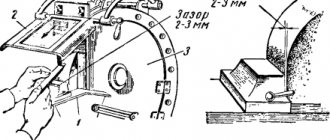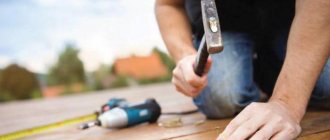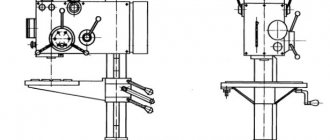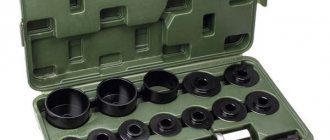Design features
Products have a welded, prefabricated or prefabricated-welded structure.
Welded cabinets are supplied ready-made and do not require assembly. The advantage of the products is that the customer can immediately start using the cabinet. The disadvantage is the difficulties that arise during transportation. Prefabricated cabinets are delivered flat-packed and assembled on site.
For the manufacture of metal cabinets with shelves and a lock, sheet steel 0.7 - 2 mm thick is used. The safety of the contents is ensured using a lock. Depending on their resistance to burglary, models are divided into classes: B0, B1, B2. Models of classes B0 and B1 have at least 1 lock, and models of class B2 have at least 2 locks.
Cabinets are coated with polymer powder paint. I would especially like to highlight paint with a “shagreen” structure, which is characterized by increased resistance to mechanical stress. The customer can choose a suitable color from the RAL catalogue, most often a light gray shade is used (RAL 7035, RAL 7040).
The complete set of metal cabinets with shelves for clothes and equipment is carried out by the manufacturer during manufacturing. If necessary, you can order a product equipped with additional hanging shelves in the closet. The shelves can be adjusted in height. The shelves can withstand loads of up to 60 kg, and reinforced shelves - up to 200 kg.
Metal cabinets with shelves for equipment and tools, used in factories and garages, are equipped with reinforced shelves that can withstand loads 2-3 times higher than conventional ones.
Basic requirements for a metalworking workbench
It is difficult to imagine the work of a metalworking master without a special work table. The workbench makes the work process more productive, comfortable and safe. Before we move on to studying the types of workbenches, it is necessary to touch upon the theory a little and remember what workbenches generally are.
In addition to metalworking shops, there are also carpentry workbenches. They are intended only for working with wood, therefore they have nothing to do with our topic at all. Universal workbenches may be of interest . They have a table top made of thick plywood with a steel sheet covering. On such a surface you can work with both metal and some wooden parts. Often, a universal workbench refers to a folding design, which is very popular among owners of small garages.
To simplify, a workbench is a desktop made in accordance with a number of requirements. The mechanic's workbench should be:
- durable and reliable to withstand the loads that your activities require;
- functional and ergonomic . The workplace must correspond to the height of the master and, if necessary, be equipped with storage areas;
- sustainable _ Quite serious work is performed on a workbench, often involving heavy loads, and a high degree of accuracy is required. This is why the workplace must be stationary;
- durable . A high-quality metalworking workbench will last at least a couple of decades.
To meet all the above requirements, workbenches have a specific design. The frame is made of durable thick metal, complemented by a powerful tabletop. The best option is an MDF board up to 30 mm thick coated with thick galvanized steel. This design will withstand high loads, and even hammer blows, and will withstand welding. Moreover, a galvanized countertop tolerates contact well with gasoline, oil, solvents and many other aggressive substances; it is easy to maintain and can be easily cleaned of dirt. For additional protection, it is coated with a layer of powder paint.
Some workbenches have sides on three sides , which prevent small objects from falling from the surface. There may also be a perforated screen , which serves to secure a mass of necessary tools, for example, screwdrivers, scissors, saws, hammers and other small things that should be literally at hand when working. The rest of the tools and documentation can be stored under the countertop, in bedside tables, drawers, and pull-out shelves specially designed for this purpose. The design of this lower part of the workbench can vary greatly - the choice is based on your own requirements and the specifics of the tools that need to be stored. As a rule, storage sections are made quite durable - they can withstand up to 35 kg. If you need to store documentation, make sure that one of the sections is locked.
If the dimensions and configuration are a matter of personal preference, then the quality of the workbench is a common requirement of all craftsmen.
Workbenches from the manufacturer in St. Petersburg
When choosing, pay attention to products that produce and sell metalworking machines, and the range of products can be found on the page https://region-peterburg.ru/verstaki/. The manufacturer uses wear-resistant alloys, carries out anti-corrosion treatment of parts and takes into account all labor safety standards. The company offers workbenches of various sizes, with and without storage places, there are reinforced structures, if necessary, it is possible to manufacture a workbench to order, and there is delivery throughout Russia.
Production "Torg-Avia"
The metal cabinet can be produced in any configuration, non-standard sizes, and equipped with the required number of shelves. Since 1995, the group has been developing and producing laboratory furniture, metal shelving, pharmacy cabinets, and commercial equipment. Modern materials that meet the requirements of the time are used in production.
The group designs and manufactures metal cabinets. The catalog contains the following models:
- for cylinders;
- for materials;
- instrumental;
- card indexes;
- archival;
- for clothes, etc.
Experience and production capacity allow us to implement complex projects. Equipment and furniture produced by Torg-Avia enterprises are covered by a free warranty.
Do you need metal cabinets with pull-out shelves? Receive a profitable commercial offer by contacting Torg-Avia specialists by phone: +7 (843) 273-78-62!
Workbench rating
When choosing nominees, we primarily relied on build quality, design reliability, and operational safety. The reputation of the manufacturer and the distinctive characteristics of its products were also taken into account. The VyborExpert team reviewed several dozen modern workbenches. They were assessed according to the following criteria:
- Materials – carpentry for wood, metalworking for metal, universal;
- Design features – body integrity, fixation strength, etc.;
- Tabletop – linoleum, MFD, plywood, galvanized sheet, polypropylene;
- Dimensions – bulkiness, weight, size, transportability;
- Additional options - cabinet, compartments, drawers, shelves, with or without a screen;
- Load – maximum permissible load capacity;
- Class – folding for household use, professional for workshops;
- Fixation – installation mechanisms, degree of reliability, stability;
- Protective coating – resistance of the housing to acids, gasoline, solvents;
- Brand, price – reliability of the manufacturer, price and quality.
The expert rating represents 10 nominees, all of them were assessed for the specified characteristics. In addition, they were distinguished by a high level of demand in the domestic and global markets. Real reviews from customers and experienced craftsmen played an important role in the selection.
Tabletop workbenches and workbenches-vises
This option is compact, mobile and lightweight, and therefore ideal for working at almost any table. The workbench can be secured with ordinary clamps for greater stability. Factory made:
And homemade desktop workbenches:
European type tabletop workbench:
Such a workbench can be installed or built even into a window sill:
There are many options for benchtop vices, both in terms of materials and design:
In our online store you can purchase a domestic beech tabletop workbench measuring 725 by 260 mm:
You can watch the technology for making such a workbench yourself in the video:
And this is what a desktop workbench for jewelry work with a stand for working with a hand jigsaw might look like:
Another version of a serial portable workbench of the European type:
and its homemade analogues:
With pipe clamp vice and wooden screw vice:
Extended versions of the desktop workbench:
The desktop workbench option, which is a ready-made tabletop, is already half a step to a full-fledged stationary workbench:
The Asian carpentry technique is distinguished by the fact that all work is carried out sitting on the floor, ground or low benches.
Therefore, their workbenches are not table-top, but floor-mounted. In our opinion, this is essentially a workbench board.
In our assortment you can also choose the following types of workbenches:
The idea of a desktop floor workbench (workbench board) was expanded by FESTOOL by creating a Systainer - a mobile workbench Sys-MFT from FESTOOL (you can buy it at the link):
In this compact product, Festool combines both a mini workbench and a storage box. Moreover, it is convenient to work not only with rectangular elements, but also with round ones due to the triangular groove in the upper surface.
Recently, quite a few homemade copies of it have appeared on the Internet:
The best universal workbenches
A combined workbench is an excellent solution for a home or professional workshop. This is both a workbench with a vice and a carpentry tool. Makes it easier to work with metal, wood, and plastic of varying densities and thicknesses. We studied the most popular offers on the market, and then selected the 3 best universal tables.
Black+Decker WM 536-XJ
A legendary universal model with increased rigidity and two height levels. Designed in the USA, made in China. A distinctive parameter is the special shape of the levers, which increases the clamping force. To fix the products, there is a vice with a width of 136 mm; they can be adjusted and firmly coupled using special stops. The tabletop is made of natural durable bamboo. The remaining parts of the structure are made of steel. The length of the working area is 610 mm, the depth is 384 mm, the total height of the table is 795 mm, and the weight is 11 kg. The maximum load capacity is 250 kg. Ease of transportation and storage is ensured by the folding mechanism of the case.
Advantages:
- Durable design;
- Special shape of levers;
- Easy to assemble and clean;
- Unique stoppers;
- Folding mechanism;
- No backlash.
Flaws:
- Insufficient height;
- The vice opens little.
Fulfills standard options and also acts as a tool storage rack, as a vice, or as a stand for cutting firewood. The height is lower than stated; if you are taller than average, it will not be very convenient to work with such a table.
Bosch PTA 2400
A table for miter saws, characterized by easy installation, practicality, and high mobility. It can be used with any materials and workpieces. To cut long panels, side extensions are additionally equipped, increasing the reliability of the workbench. Another difference of the device is the presence of a universal chuck, which is compatible with PCM miter saws and a Bosch PBD 40 drilling machine. Installation is carried out without additional tools. Dimensions 1220x820 mm, extension increases the working area to 2440 mm, weight 20.4 kg. The support is adjustable to the desired height and angle of inclination, which greatly simplifies operation. Maximum load – 160 kg.
Advantages:
- Quick readiness for use;
- Universal mount;
- Extension element;
- Stable position;
- Adjustable height;
- Rich equipment.
Flaws:
- Price;
- Small vice width.
The model belongs to the DIY series, that is, a tool for home use. The universal mount is synchronized with most other Bosch brand devices (saws, drills, etc.). Users approve of the lack of play and the ability to adjust horizontal installation on uneven surfaces.
Berger BG1298
A folding universal workbench that differs from previous nominees in its thoughtful design, ease of access to the work area, and compactness. This is a portable clamping system that holds any materials and products. You can store it folded; the box will fit in the trunk of a car, which increases the mobility and transportability of the device. Load capacity is up to 300 kg, the size of the clamped object is no more than 960 mm, the degree of pressure with a vice is 1000 kg due to the fact that this is done with a pedal and lever. With a weight of 14.5 kg, it has dimensions of 980x860x880 mm. To increase the gripping area, the moving part is reversed.
Advantages:
- Multifunctionality;
- Ease of management;
- Quick transformation from working to transport position and vice versa;
- Increased capture area;
- Set of replacement pads;
- Foot clamp, lever.
Flaws:
- Price;
- You need to buy additional cast iron and steel jaws.
The kit includes a set of universal polyurethane pads. If desired, they can be replaced with steel, cast iron options, with teeth, if the owner has to work with metal products or wood. There are also detailed instructions on what design changes are permissible.
The best clamps
Which workbench is better
You need to choose a table for processing materials taking into account the availability of free space, load, number of devices used, and additional equipment. Furniture for the garage and a workbench for the workshop are two radically different designs. Having compared the pros and cons of the rating nominees, Vyborexperta.ru recommends the following models:
- Sparta 257055 640×520 mm – the lightest model with strong non-slip supports;
- Bison Master M5 (38726) 605×120 mm – an economical wooden workbench with inclined doors, adjustable in width;
- Hammer VRS100 605×360 mm – metal table with markings and tilt angle adjustment;
- Proffi-116 D5 – a spacious table, you can install 2 perforated screens on it;
- Bosch PTA 2400 – extension element, excellent stability, universal fastenings;
- Berger BG1298 is a universal multifunctional workbench with increased pressure and compact dimensions.
Each nominee in the rating guarantees reliability, stability, and long service life. Choosing a workbench is a purely individual decision, depending on the purpose, characteristics and financial capabilities.
How to make a carpentry table with your own hands
Creating a carpentry table with your own hands, despite all its features, is quite simple. To do this you need:
- Calculate exact dimensions.
- Create a preliminary drawing.
- Select the necessary boards and other materials.
- Refine the drawing.
- Assemble the table itself.
A modern work surface is also additionally equipped, for example, with space for a milling machine.
Size calculation
The basic size requirements are simple: the table must fit in the room so that it is convenient to walk around it with a tool. To do this, a distance of 80-100 cm should remain between it and the wall or other objects.
The size of the table is determined by factors such as the area of the room and your individual characteristics.
The size of the tabletop should be such that it is convenient to place everything you need on it. If you plan to work with small objects, then a length of 100–150 cm and a width of 80 cm will be sufficient. If you plan to process large objects, then it is better to choose a length of 200–250 cm and a width of 80–100 cm.
Ideally, the height should be such that it is comfortable to work behind it while standing or sitting on a chair. To do this, it must be 70 cm. A height of 80 cm will allow you to work only while standing.
Working at a workbench that is not the right height will lead to serious back problems.
Drawing
Once the basic dimensions have been determined, you can begin creating the drawing. You need to pay close attention to this, since the details will then be cut out from it.
Drawings of the future structure, as well as its dimensions, are selected taking into account all conditions.
The drawing is performed in two versions:
- Table top drawing.
Here the width of the boards is calculated and how they will be connected to each other. The necessary clamps and vices are also indicated here. Important! It is worth trying on the location of important elements in real size, trying from which points it is convenient to reach them with your hands and checking whether they interfere with work. - Basic drawing. Here it is important to calculate the load on the legs and how the frames will be strengthened.
Drawings of tables that can be found on the Internet are presented in a huge variety.
After this, it is worth checking the drawing again and its compliance with the materials: whether there are boards of the required width or the required number. Are the necessary support bars available?
Selection of tools and materials
Before assembling the table, you need to prepare all materials and tools.
Necessary materials:
- Wooden boards are 15-30 cm wide and 6-7 cm thick. Their length should be no less than the length of the table top. The cheapest regular pine board is suitable for this.
- Wooden blocks for the frame, legs and drawers. The width of the bars should be 10-15 cm.
- Square metal pipes for making metal supports.
- Metal furniture corners for connecting wooden parts.
- Self-tapping screws and bolts.
- Wood glue.
It’s great if you can find lumber made from beech, ash, maple or hornbeam, but if not, then make a table from a pine board.
Tools needed for assembly:
- Hammer.
- Jigsaw.
- Hand saw.
- Grinder saw.
- Screwdriver.
- Ruler.
- Roulette.
- Pencil.
For convenience, tools and small parts should be placed on one side, and large boards should be placed on the other.
Other tools may be required, but this will depend on the design of your workbench.
Advice. Small parts and screws should be laid out on a light cloth or paper. This way you can immediately find the item you need.
Table creation process
Assembling a workbench involves several steps:
- Frame assembly. She's going first. The supports are fastened together using drawers and crossbars. For the most reliable fastening, they are connected using wedges or puzzles, which must be prepared in advance. A simpler connection is also possible using metal brackets and furniture corners. The metal base is assembled using welding or screws.
- Creating a tabletop. First, boards of the required size are cut.
- Fastening the table top to the frame. To do this, furniture corners are attached to the boards, then they are installed on the frame and attached to it. If a folding tabletop is intended, then you first need to make its parts and then connect them to the frame using furniture hinges.
- Creation of additional elements: clips, puzzles and others. After the tabletop is installed and secured to it, it is convenient to attach additional elements: clamps, vices. Here you can also cut out the necessary holes with a jigsaw.
The tabletop is treated with a surface planer and a sander to achieve a smooth surface.
Advice. When assembling the table, do not use nails. This will subsequently cause the table to become loose. Self-tapping screws can always be re-tightened. Puzzles and wedges are firmly connected with glue.
After assembly, all that remains is to prepare the table for work and you can begin the creative process.
The base is impregnated with an antiseptic, which will not allow fungus or mold to grow in the wood.
Final stage
Finally, it is necessary to check the strength of all connections and modify those that may become loose.
It is also important to check the comfort of all parts on the countertop. Most likely, something will seem superfluous, and something will be missing. To be more confident, you should try working on a large object on a workbench. In this case, nuances will certainly appear that can be quickly corrected before installing additional equipment and securing the table.
You can make a shelf on the bottom frame, or one or two cabinets. Careful craftsmen make a cabinet and a shelf on which various equipment is stored.
The very last step in creating a woodworking table will be attaching it to the floor. The table is usually screwed to the floor using furniture corners. This ensures its stability and ease of support during operation.
Mobile devices intended for small items do not need to be screwed to the floor. But in this case there will still be a risk of knocking it over.
Types of workbenches by type of design
According to their shape, size and type of construction, all workbenches are divided into several types:
- Stationary models.
- Mobile workbenches.
- DIY folding workbenches.
All presented types of workbenches can be made with your own hands. This parameter is of utmost importance. For working with wood and restoring old furniture, it is better to install stationary workbenches on which automatic saws, planes, and specialized clamps are placed.
To carry out repairs of automobile parts, on the contrary, preference is given to mobile structures (on wheels or on stands).











